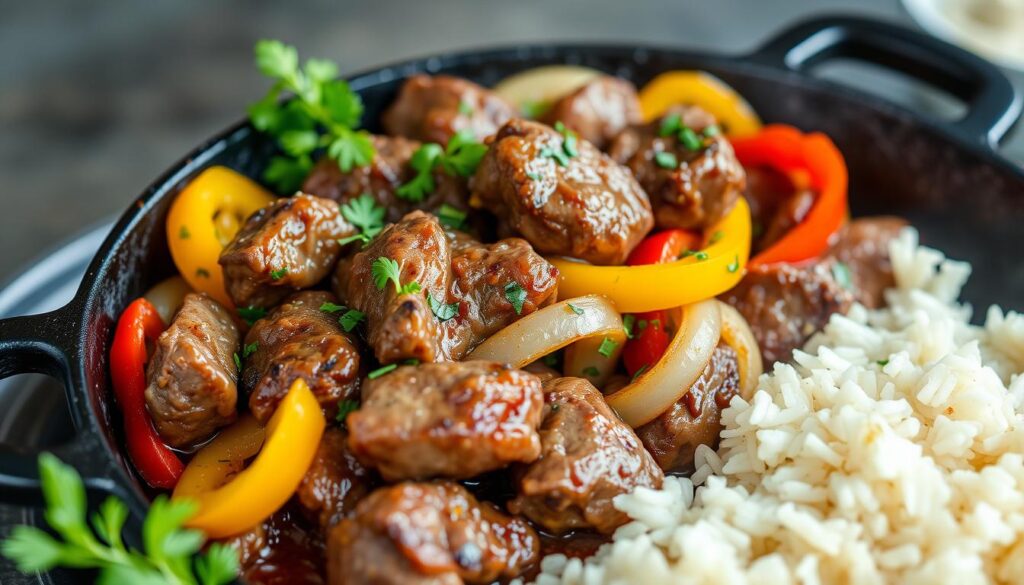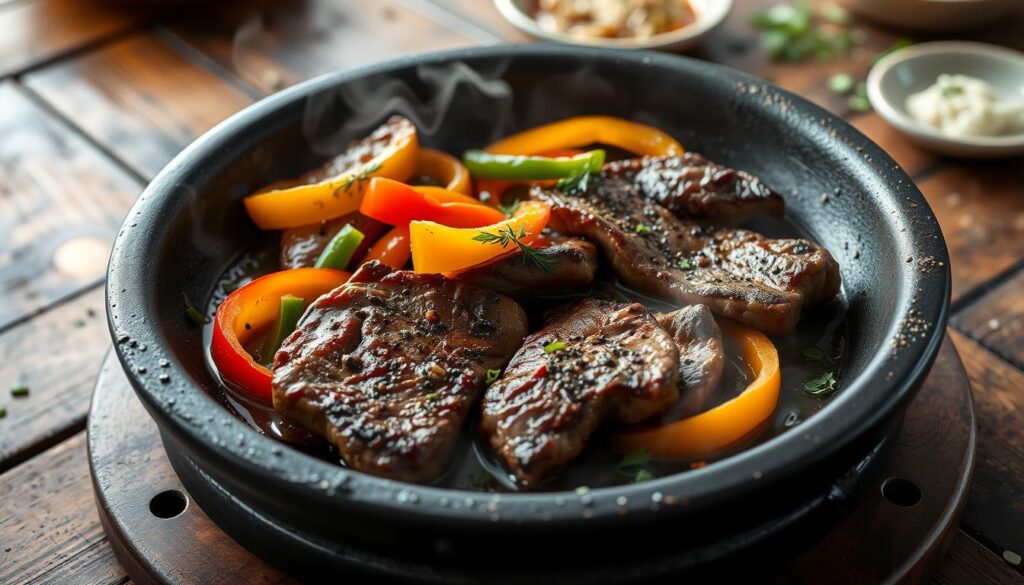Growing up in a Puerto Rican home, the smells of sofrito, sazón, and adobo filled the air. These scents meant a delicious lunch was on its way. They brought back memories of family times and the rich culture that shaped my cooking.
Today, I’m excited to share with you a collection of puerto rican lunch recipes. These dishes will take your taste buds on a trip to the Caribbean.
Puerto Rican food is a mix of Spanish, African, and Taíno flavors. This mix makes for a unique and delicious experience. This article will show you some of the most loved and easy puerto rican midday meals. You’ll learn how to make these dishes and bring the island’s flavors to your home.
Table of Contents
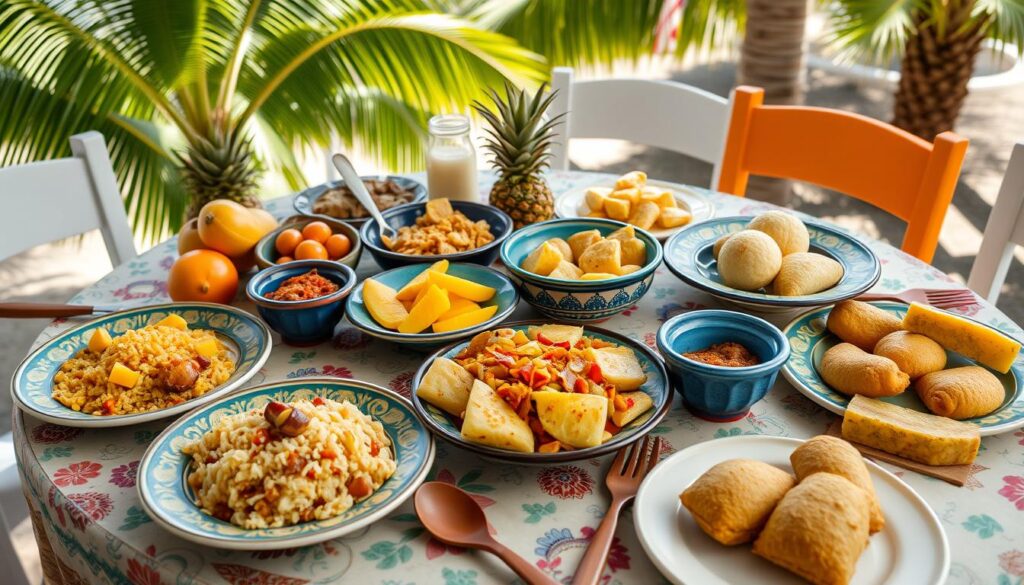
Key Takeaways
- Discover the essential elements of authentic puerto rican cuisine, including sofrito, adobo, sazón, plantains, and rice and beans.
- Explore a variety of puerto rican lunch recipes that showcase the diverse flavors and techniques of this vibrant culinary tradition.
- Learn about the versatility of ingredients like plantains, yucca root, and various beans in puerto rican staple dishes.
- Uncover the role of traditional seasonings like sazon, adobo, and sofrito in enhancing the flavors of puerto rican comfort food.
- Discover how to incorporate puerto rican midday meals into your own culinary repertoire, bringing the essence of the Caribbean to your table.
The Essence of Puerto Rican Cuisine
Puerto Rican cuisine is a mix of Spanish, African, and Indigenous flavors. It’s known for its rich tastes and deep cultural roots. A few key ingredients and cooking methods capture the essence of Puerto Rican cooking.
Sofrito: The Aromatic Foundation
Sofrito is the base of many Puerto Rican dishes. It’s a mix of herbs and vegetables that adds flavor. This puerto rican sofrito includes garlic, onions, cilantro, and peppers. It gives Puerto Rican food its unique smell and taste.
Adobo: The Versatile Seasoning Blend
Puerto rican adobo seasoning is a key part of Puerto Rican cooking. It’s a mix of garlic, oregano, and pepper. This blend is used to marinate and season many dishes, adding depth to their flavors.
Sazón: The Signature Flavor Enhancer
Puerto rican sazón seasoning adds a special color and flavor to many recipes. It includes coriander, annatto, and other spices. This seasoning is essential for getting the true taste of Puerto Rican food.
Plantains: The Versatile Staple
Puerto rican plantains, both green and ripe, are used in many dishes. They’re like bananas but starchier. They’re used in everything from savory fritters to sweet desserts, showing their versatility.
Knowing the importance of these puerto rican staple ingredients helps us understand Puerto Rican cuisine. These ingredients, along with the culture, make the dishes loved by food lovers worldwide.
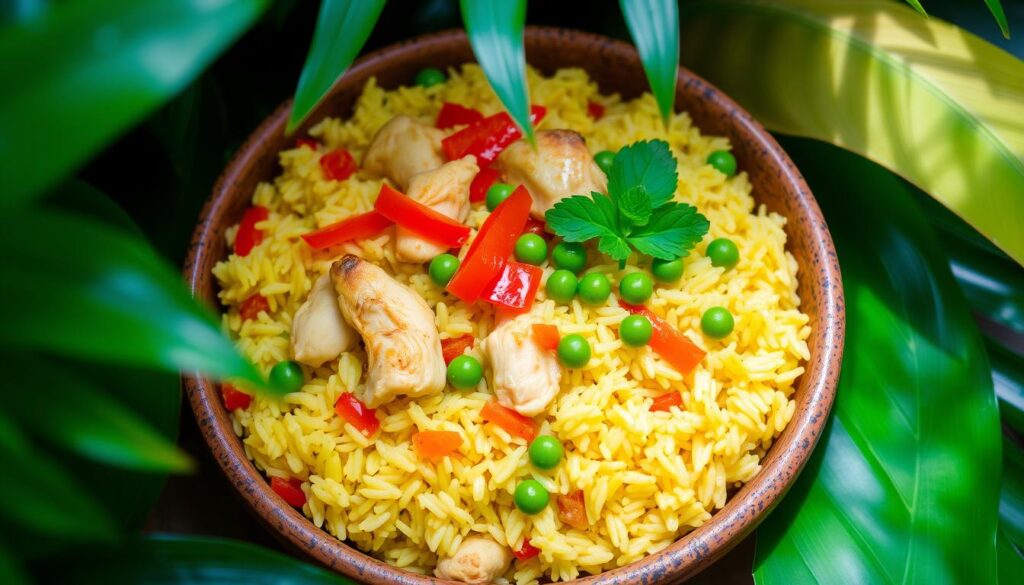
Arroz con Pollo (Chicken and Rice)
Arroz con Pollo is a classic Puerto Rican dish. It’s a hearty, flavorful one-pot meal perfect for lunch. The recipe combines seasoned chicken thighs with fragrant rice. It’s simmered in a broth with sofrito, tomato sauce, and Puerto Rican spices.
This recipe makes 4-6 servings and is loved by many. It’s gluten-free and can be made in about 30 minutes. You’ll also need 30 minutes to an hour to marinate the chicken.
| Ingredient | Amount |
|---|---|
| Chicken drumsticks | – |
| Achiote (annatto) oil or olive oil | 2 tbsp |
| Sofrito | 2 tbsp |
| Yellow onion, diced | 1 large |
| Garlic, minced | 4 cloves |
| Bell pepper, diced | 1 |
| Cilantro, minced | 1/2 cup |
| Tomato sauce | 1/4 cup |
| Green olives, stuffed with pimento and sliced in half | 1 cup |
| Frozen peas | 2 cups |
| Rice | 2 1/2 cups |
| Chicken broth | 4 cups |
| Water | 1 cup |
To make this arroz con pollo, marinate the chicken first. Then, sauté it with sofrito, onions, garlic, and peppers. Add rice, tomato sauce, olives, peas, and broth. Simmer until the rice is tender and flavors blend.
For a quicker version, use a rice cooker or Instant Pot. Cooking time is about 12 minutes. Rinsing the rice makes it fluffier. You can also add saffron, sweet corn, or cilantro for extra flavor.
Arroz con Pollo is a favorite in Latin American cuisine. The Puerto Rican version has a yellow color from annatto and herbal notes from recaito. Serve it with avocado slices and a side salad for a complete meal.
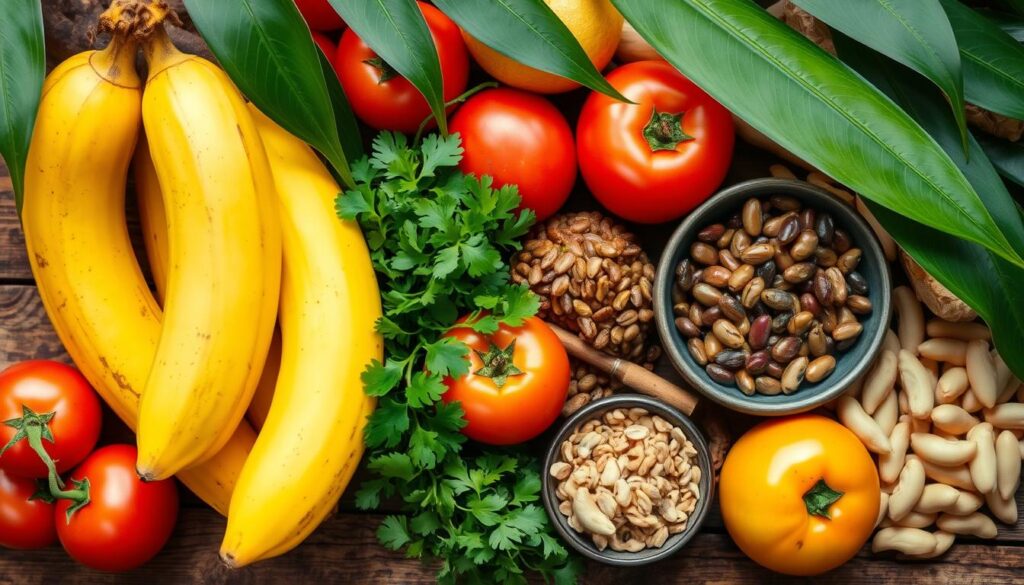
Mofongo con Camarones (Plantain Mash with Shrimp)
Experience the rich flavors of Puerto Rico with Mofongo con Camarones. This dish combines the island’s favorite ingredients. At its core is mofongo, a plantain mash that contrasts with the tender shrimp in a flavorful sauce.
To make this dish, you’ll need 1 pound of large shrimp, 1/2 cup of olive oil, 1 1/2 cups of chicken broth, and 6 garlic cloves. For the mofongo, use 5-6 green plantains, 4 tablespoons of salted butter, and a small bag of pork rinds or homemade chicharrones.
First, sauté the shrimp in olive oil with diced tomatoes and garlic. Add Adobo All Purpose Seasoning and a bit of ketchup for sweetness. Meanwhile, fry the plantains for 7-10 minutes on each side. Then, mash them with olive oil, butter, garlic, and chicharrón. Shape the mash into a round mound using a greased bowl.
Finally, place the sautéed shrimp on top of the mofongo. Garnish with fresh cilantro. This mofongo with shrimp dish highlights the vibrant tastes of Puerto Rican cuisine. It’s a nutritious and satisfying lunch, with about 300 calories per serving.
| Ingredient | Quantity |
|---|---|
| Large shrimp | 1 pound |
| Olive oil | 1/2 cup |
| Chicken broth | 1 1/2 cups |
| Garlic cloves | 6 |
| Green plantains | 5-6 |
| Salted butter | 4 tablespoons (1/2 stick) |
| Pork rinds (or chicharrones) | 1 small bag |
| Whole shrimp for garnish | 12 |
Enjoy this delightful Puerto Rican mofongo dish. The crisp yet soft mofongo and the juicy shrimp blend in a symphony of flavors. It’s a satisfying meal for any time of day.
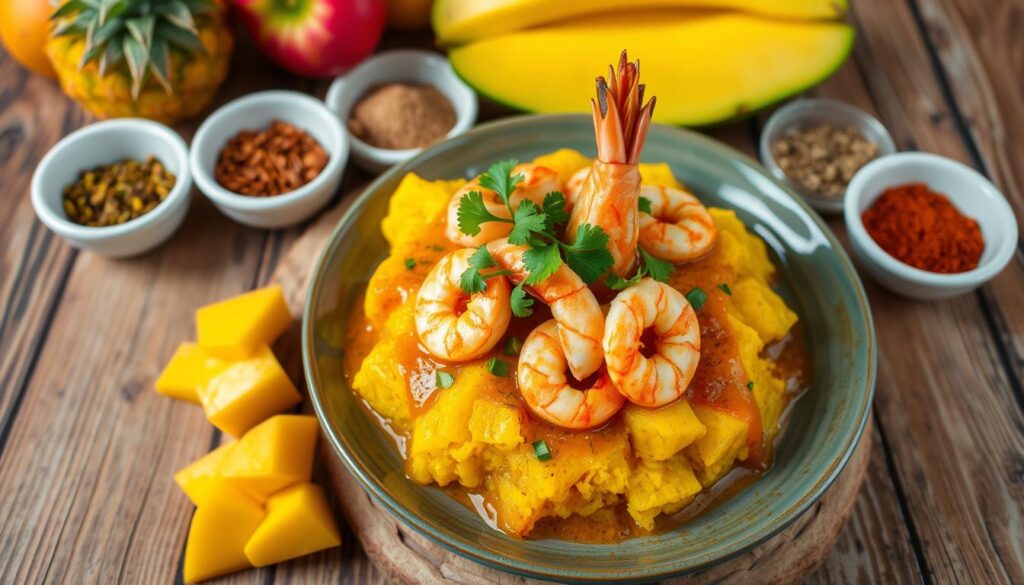
Empanadillas de Carne (Beef Turnovers)
Experience the flavors of Puerto Rico with these puerto rican empanadillas, also known as puerto rican beef turnovers. These savory pastries are perfect for a quick and tasty puerto rican lunch. They capture the essence of the island’s vibrant cuisine.
The secret to these puerto rican empanadillas is the seasoned ground beef filling. It’s mixed with sofrito, olives, and spices. The flaky, golden-brown dough complements the filling, offering a perfect balance of flavors and textures.
Perfect for Lunch on the Go
Empanadillas are the ultimate portable lunch. They let you enjoy a taste of Puerto Rico anywhere. With a recipe that makes at least 2 1/2 dozen mini empanadillas, you can prepare a batch in advance. This way, you have a delicious meal ready to go.
The filling is versatile and can be used for extra servings or over rice. It’s a budget-friendly option. Sealing the empanadillas with a fork creates a distinctive, crimped edge. This gives them a professional-looking and authentic finish.
To get the perfect empanadilla shape, use a cup or round cookie cutter. Refrigerate the dough for at least 30 minutes before assembling. This makes handling easier.
While baking is an option, frying is recommended for a more authentic flavor and texture. The good news is that empanadillas can be prepared in advance and frozen. This makes them a convenient and delicious option for busy days.
So, why not treat yourself to the flavors of Puerto Rico with these puerto rican beef turnovers? They’re perfect for a quick and satisfying lunch or a taste of the island’s rich culinary heritage. These puerto rican empanadillas are sure to satisfy.
Tripleta Sandwich
The tripleta sandwich is a favorite in Puerto Rico. It mixes savory, salty, and tangy tastes. Made with beef, chicken, and ham, it’s a filling meal that’s loved by many.
This sandwich has marinated cube steak, roast pork, and ham. It’s topped with lettuce, tomatoes, onions, and mayo-ketchup. The steak is marinated to make it tender and tasty.
There are many variations of the tripleta. You can find chicken, turkey, salami, prosciutto, or even vegan options like mushrooms or tofu. It shows the variety and richness of Puerto Rican street food.
The tripleta sandwich is great for a quick lunch or a big meal after a night out. Its big portions and balanced flavors make it a favorite among both locals and tourists.
Habichuelas Guisadas (Stewed Beans) with Arroz Blanco (White Rice)
A Comforting Classic Combo
Puerto Rican cuisine is famous for its tasty and healthy dishes. A classic combo is Habichuelas Guisadas (Stewed Beans) with Arroz Blanco (White Rice). This combo is a favorite in Puerto Rican homes, perfect for lunch or dinner.
The Habichuelas Guisadas get their rich flavor from Puerto Rican sofrito, sazón, and adobo. The beans are cooked until they’re tender and full of flavor. They’re mixed with tomato sauce, pumpkin, and olives. This makes a hearty dish that’s both nourishing and delicious.
Arroz Blanco (White Rice) is the perfect match for the beans. It’s light, fluffy, and easy to make. Together, the rice and beans make a filling meal that shows off Puerto Rican comfort and tradition.
If you want to try Puerto Rican food or need a satisfying lunch, try this combo. Add avocado and tostones (fried green plantains) for a true Puerto Rican meal. It will make you feel full and energized.
| Ingredient | Quantity |
|---|---|
| Oil | 1 tablespoon |
| Sofrito | 2 heaping tablespoons |
| Tomato sauce | 8 ounces |
| Canned kidney, red or pink beans (drained and rinsed) | 2 cans (15-16 ounces each) |
| Water | 1 1/2 cups (12 ounces) |
| Sazón with Coriander and Annatto (Culantro and Achiote) | 1 packet |
| Ham flavor (Goya Jamón) (optional) | 1 packet |
| Adobo (Goya) | 1 teaspoon |
| Garlic powder | 1/2 teaspoon |
| Dried oregano | 1/4 teaspoon |
| Ground black pepper | to taste |
| Manzanilla or Spanish pimento-stuffed olives | 2 tablespoons |
| Potatoes (peeled and diced into large chunks) | 1/2 pound |
| Cooked white rice | for serving |
The secret to Habichuelas Guisadas (Stewed Beans) is Puerto Rican sofrito, sazón, and adobo seasonings. The beans are cooked until tender, then mixed with tomato sauce, pumpkin, and olives. Serve over Arroz Blanco (White Rice) for a comforting Puerto Rican lunch.
Tostones with Garlic Sauce
Explore the world of puerto rican tostones, or twice-fried plantains. They are a favorite puerto rican side dish that makes a great light lunch. The crispy, golden fried plantains pair well with a tangy garlic sauce for dipping.
To make tostones, you fry the plantain slices twice. First, they’re fried for 1-2 minutes until they’re lightly golden. Then, they’re flattened and fried again for 2-3 minutes. This makes them crispy on the outside and sweet inside.
The garlic sauce is made with cilantro, garlic, olive oil, and more. It’s zesty and aromatic, making the tostones even better.
These tostones with garlic sauce are great as a puerto rican side dish or a light lunch. They show off the rich flavors of Puerto Rican cuisine. Whether you love puerto rican tostones or are trying them for the first time, you’ll love them.
“The tostones with garlic sauce are a must-try! The perfect balance of crispy, sweet, and savory flavors – a true taste of Puerto Rico.”
- 2 green plantains, peeled and sliced into 1-inch pieces
- 1-2 cups of oil for frying
- 1 cup fresh cilantro
- 4-6 cloves of garlic, minced
- 2 tablespoons of olive oil
- 1 tablespoon of red wine vinegar
- Juice of 2 limes
- 1 teaspoon of crushed red pepper
- 1 teaspoon of honey
- 1/2 teaspoon of kosher salt
- 1/2 teaspoon of black pepper
With a few simple steps, you can make authentic Puerto Rican flavors at home. Enjoy the crispy tostones with the vibrant garlic sauce for a delicious lunch.
puerto rican lunch recipes
Discover the vibrant and authentic flavors of Puerto Rican cuisine with this collection of mouthwatering lunch recipes. From hearty one-pot meals to portable and satisfying options, these dishes offer a delightful taste of the island’s culinary traditions. Whether you’re craving a comforting classic or seeking to explore new and exciting flavors, these authentic puerto rican lunch recipes will delight your taste buds and transport you to the Caribbean.
Pork is a prominent protein in puerto rican traditional dishes, featured in dishes like Roasted Pernil, Slow Cooked Puerto Rican Pork (Pernil), and Whole Pig Roast (Lechón Asado). Chicken also plays a significant role, with options such as Guava BBQ Chicken Thighs and Chicharrones de Pollo (Puerto Rican Fried Chicken). Seafood holds a special place in puerto rican comfort food recipes, with dishes like Ensalada de Bacalao (Salted Cod Salad) being a popular choice along the coasts.
Rice is a staple in puerto rican midday meals, with favorites like Arroz con Gandules (Rice and Pigeon Peas) and Arroz con Pollo (Chicken and Rice). Plantains, on the other hand, are a versatile ingredient used in dishes such as Tostones (Twice Fried Plantains) and Pastelon (Puerto Rican Sweet Plantain Lasagna).
| Dish | Key Ingredients | Cuisine Style |
|---|---|---|
| Arroz con Pollo (Chicken and Rice) | Chicken, rice, peas, peppers, olives | Traditional Puerto Rican |
| Mofongo con Camarones (Plantain Mash with Shrimp) | Plantains, shrimp, garlic, pork crackling | Coastal Puerto Rican |
| Empanadillas de Carne (Beef Turnovers) | Ground beef, turnover dough, olives | Puerto Rican Antojitos |
Explore the diverse array of puerto rican lunch recipes and discover the rich flavors that make Puerto Rican cuisine a true culinary delight. Whether you’re craving a hearty one-pot meal or a portable and satisfying option, these dishes will transport you to the heart of the Caribbean.
Ensalada de Bacalao (Codfish Salad)
Get ready to enjoy a refreshing and protein-rich treat with Puerto Rican Ensalada de Bacalao, or Codfish Salad. It’s a great puerto rican lunch for hot, humid days. You’ll love its light and flavorful taste.
The recipe starts with 1 lb of salted dry cod. It’s boiled for 10 minutes and then rinsed twice in cold water. This removes excess salt and makes the puerto rican seafood tender and flavorful.
| Ingredient | Amount |
|---|---|
| Salted Dry Cod (Bacalao) | 1 lb |
| Tomato, diced | 1 |
| Avocado, cut in chunks | 1 |
| Hard Boiled Eggs, quartered | 2-3 |
| Olive Oil | Optional |
| Vinegar | Optional |
Once the cod is ready, the salad comes together fast. The bacalao is mixed with diced tomatoes, avocado, and hard-boiled eggs. A simple vinaigrette made with olive oil and vinegar brings all the flavors together. This creates a light and refreshing puerto rican lunch full of nutrients.
Chilled for about 45 minutes, this puerto rican codfish salad is a perfect mix of textures and tastes. It will make you feel full and energized. You can enjoy it alone or with your favorite sides for a complete puerto rican lunch.
Alcapurrias de Jueyes (Stuffed Crab Fritters)
Explore the charm of puerto rican alcapurrias, a favorite Puerto Rican fried treat. These golden bites are filled with a tasty puerto rican crab fritters mix. They’re made from green plantains and fried to a perfect crisp. puerto rican lunch recipes
The secret to these tasty puerto rican fried appetizers is their mix of textures and tastes. The outside is crunchy, while the inside is soft and full of crab. They’re great as an appetizer or a filling lunch, showing off Puerto Rican flavors. puerto rican lunch recipes
To make these alcapurrias, green plantains are used to create a dough. This dough is shaped into cups and filled with crab. Then, they’re fried until golden, creating a crispy outside and a soft inside. puerto rican lunch recipes
“Alcapurrias are a true taste of Puerto Rico, transporting you to the vibrant street markets and family gatherings of the island.”
Each batch of alcapurrias makes about 32 fritters. They’re perfect for sharing or enjoying alone. With 392 calories and 39 grams of fat per serving, they’re a rich treat. puerto rican lunch recipes
Whether you love Puerto Rican food or are new to it, these puerto rican crab fritters are a must-try. Enjoy the crispy, savory goodness of alcapurrias and experience Puerto Rican culture through your taste buds. puerto rican lunch recipes
Piña Colada Smoothie
Make your Puerto Rican lunch feel like a tropical getaway with a piña colada smoothie. This creamy drink is like the famous Caribbean cocktail, but without the alcohol. It’s perfect for a light lunch or to quench your thirst. puerto rican lunch recipes
This puerto rican tropical drink is easy to make with just four ingredients: coconut milk, banana, pineapple, and optional honey. The frozen fruit makes it thick and cold, while the coconut milk adds a creamy touch. puerto rican lunch recipes
To make this puerto rican smoothie recipe, blend the ingredients until they’re smooth. You can adjust the honey to your liking because of the banana and pineapple’s sweetness. Enjoy this refreshing drink on a hot day or when you need a midday boost. puerto rican lunch recipes
The piña colada smoothie is great for any Puerto Rican lunch or if you just want a tropical treat. It brings the island’s lively flavors right to you. With every sip, imagine yourself on Puerto Rico’s beaches and under its palm trees.
Conclusion
This collection of Puerto Rican cuisine and Puerto Rican lunch recipes highlights the island’s rich flavors. It includes hearty dishes like Arroz con Pollo and Habichuelas Guisadas. Also, there are tasty options like Empanadillas de Carne and the Tripleta Sandwich.
These recipes bring the taste of Puerto Rico right to your table. Whether you’re looking for a comforting dish or something new, these Puerto Rican lunch recipes will take you to the Caribbean. They leave you feeling full and happy.
Try the Chicharrones de Pollo, the Pernil Asado, and the Vanilla Flan. These dishes are part of what makes puerto rican lunch recipes Rican cuisine so special. Whether you’re a fan or new to these flavors, these recipes will amaze and inspire you.
FAQ
What are the key ingredients and flavor profiles in Puerto Rican cuisine?
Puerto Rican food is known for its main ingredients. These include sofrito, adobo, sazón, and plantains. Both green and ripe plantains are used. puerto rican lunch recipes
What is Arroz con Pollo?
Arroz con Pollo is a famous Puerto Rican dish. It has seasoned chicken thighs with fragrant rice. The rice is cooked in a broth with sofrito, tomato sauce, and spices. puerto rican lunch recipes
What is Mofongo?
Mofongo is a favorite dish in Puerto Rico. It’s made from fried and mashed plantains. When served with shrimp in a savory sauce, it’s a must-try lunch. puerto rican lunch recipes
What are Empanadillas?
Empanadillas are savory turnovers from Puerto Rico. They’re filled with seasoned ground beef, sofrito, and olives. They’re a tasty and easy lunch option. puerto rican lunch recipes
What is a Tripleta Sandwich?
The Tripleta is a big Puerto Rican sandwich. It has beef, chicken, and ham. This sandwich is a favorite street food, filling and satisfying. puerto rican lunch recipes
What is Habichuelas Guisadas?
Habichuelas Guisadas are stewed Puerto Rican beans. They’re served with fluffy Arroz Blanco. This combo is a classic, comforting lunch. puerto rican lunch recipes
What are Tostones?
Tostones are twice-fried plantains. They’re a popular side dish. Served with garlic sauce, they make a light and tasty lunch. puerto rican lunch recipes
What is Ensalada de Bacalao?
Ensalada de Bacalao is a refreshing Puerto Rican Codfish Salad. It’s a light and protein-rich lunch. It offers a mix of flavors and textures. puerto rican lunch recipes
What are Alcapurrias?
Alcapurrias are fried fritters from Puerto Rico. They’re made with green plantains and filled with crab. They’re a unique and satisfying lunch option. puerto rican lunch recipes
What is a Piña Colada Smoothie?
The Piña Colada Smoothie is a creamy treat. It captures the Caribbean’s flavors. It’s a refreshing and indulgent option for lunch or a drink. puerto rican lunch recipes
Source Links
- 7 Authentic Puerto Rican Lunch Recipes: A Taste of Caribbean Flavor – https://www.sporkrecipes.com/2024/10/13/puerto-rican-lunch-recipes/
- Most Popular Latin-Puerto Rican Foods + Recipes – Healthy Rican – https://healthyrican.com/most-popular-latin-puerto-rican-foods-recipes/
- 30+ Classic Authentic Puerto Rican Recipes – Salima’s Kitchen – https://salimaskitchen.com/puerto-rican-recipes/
- Sofrito, the Essence of Puerto Rican Cuisine: Gelabert, Blanche: 9780615402918: Amazon.com: Books – https://www.amazon.com/Sofrito-Essence-Puerto-Rican-Cuisine/dp/0615402917
- Puerto Rican Food! Iconic Meals that Will Blow Your Mind – https://eclecticemissary.com/2023/03/22/puerto-rican-food-iconic-meals-that-will-blow-your-mind/
- Authentic Puerto Rican Arroz Con Pollo | Salima’s Kitchen – https://salimaskitchen.com/puerto-rican-arroz-con-pollo/
- Arroz Con Pollo | Puerto Rican Rice With Chicken – https://latinamommeals.com/arroz-con-pollo-puerto-rican-rice-with-chicken/
- Arroz Con Pollo (Puerto Rican Chicken and Rice) – https://www.budgetbytes.com/arroz-con-pollo/
- %%title%% Recipe | The Great American Recipe | PBS Food – https://www.pbs.org/food/recipes/mofongo-con-camarones
- Puerto Rican Shrimp Mofongo – Nata Knows Best – https://www.nataknowsbest.com/puerto-rican-shrimp-mofongo/
- Mini Empanadillas (Puerto Rican Beef Turnovers) – https://thelatinahomemaker.com/mini-empanadillas-beef-turnovers/
- Puerto Rican Empanadas – Empanadillas/Pastelillos – Nata Knows Best – https://www.nataknowsbest.com/puerto-rican-empanadas/
- Tripletas (Puerto Rican Steak, Pernil, and Ham Sandwiches) – https://senseandedibility.com/tripletas/
- Vegan Tripleta Sandwich – Puerto Rican Tripleta – https://thehungrydragonfly.com/2024/03/vegantripletasandwich/
- Puerto Rico’s Tripleta | Sandwich Tribunal – https://www.sandwichtribunal.com/2020/01/puerto-ricos-tripleta/
- Arroz y Habichuelas Guisadas/Rice and Puerto Rican Stewed Beans – – https://plantbasedboricua.com/recipes/arroz-y-habichuelas-rice-and-beans/
- Puerto Rican Rice and Beans (Habichuelas Guisadas) | Kitchen Gidget – https://www.kitchengidget.com/2013/12/02/puerto-rican-rice-beans/
- Garlic Tostones: Puerto Rican Fried Plantains with Rice and Beans – https://pinchofyum.com/garlic-tostones-puerto-rican-fried-plantains
- Tostones Recipe – https://www.sophisticatedgourmet.com/2020/07/tostones-recipe/
- Tostones With Cilantro Garlic Sauce – Honeyed Sundays – https://honeyedsundays.com/2020/12/03/tostones-with-cilantro-garlic-sauce/
- Puerto Rican Recipes | Get All My Recipes in One Place – https://thenoshery.com/puerto-rican-recipes/
- 24 Wonderful Puerto Rican Recipes – Drizzle Me Skinny! – https://drizzlemeskinny.com/24-wonderful-puerto-rican-recipes/
- Ensalada de Bacalao – https://www.jeffandjopr.com/post/ensalada-de-bacalao
- Ensalada de Bacalao (Salted Cod Salad) – https://thenoshery.com/bacalao-salted-cod-salad/
- Recipe Idea for Lent: Ensalada de Bacalao (Puerto Rican Codfish Salad) – modernmami™ – https://www.modernmami.com/latino-latina-culture/puerto-rico/puerto-rican-codfish-salad-ensalada-de-bacalao/
- Alcapurrias de Jueyes (Crab-Stuffed Fritters) Recipe – https://cooking.nytimes.com/recipes/1021990-alcapurrias-de-jueyes-crab-stuffed-fritters
- Alcapurrias de Jueyes – https://www.deaixa.com/recetas/2021/04/alcapurrias-de-jueyes/
- Super Easy Pina Colada Smoothie {3 Ingredients!} – Grandbaby Cakes – https://grandbaby-cakes.com/pina-colada-smoothie-recipe/
- Sips From Puerto Rico: Pina Colada (with Recipe) – Traveling with MJ – https://www.travelingwithmj.com/sips-from-puerto-rico-pina-colada/
- Authentic Puerto Rican Piña Colada Recipe: Taste Paradise In Every Sip | Puerto Rican Recipes | 30Seconds Food – https://30seconds.com/food/tip/69877/Authentic-Puerto-Rican-Pina-Colada-Recipe-Taste-Paradise-In-Every-Sip
- Puerto Rican food – Carlos Eats – https://carloseats.com/tag/puerto-rican-food/
- Why Spam Guisada Is the Perfect Dish to Make Right Now – https://www.eater.com/2020/5/27/21264216/spam-guisada-puerto-rican-dish-recipe-history

